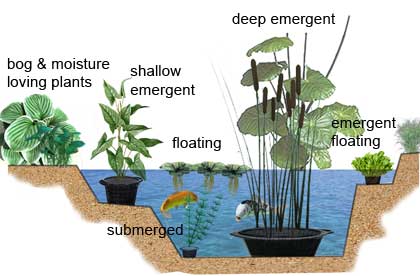Edible Water Garden Design
Plants suitable for water gardens range from those that require moist soil to those that thrive in deep water. They are usually grouped into six categories although some plants will fall in to 2 or more categories. The categories are: oxygenators, deep-water plants, surface floaters, marginals, bog plants, and moisture loving plants. When buying plants be careful to check their requirements as some garden nurseries will group moisture-loving plants (which cannot be in waterlogged soil) along with bog plants. For more information on water gardens view our page: The Edible Pond and Bog Garden, in the Habitat section.

The table below gives examples of plants falling into the different categories
Water Garden Plants
Oxygenators Fast-growing submerged plants that help to clean and oxygenate the water. e.g. Myriophyllum spicatum (Water Milfoil) Myriophyllum verticillatum (Myriad Leaf) Elodea canadensis (Canadian Pondweed) Essential if fish are added to the pond.
Shallow Emergent (shallow marginals). Grow in shallow water usually about 8 -15 cm (3"-6"). Shallow marginals provide cover for wildlife and are a key ornamental element to a water garden design.
Deep Emergent (water depth 6" -12") Nelumbo lutea (American Water Lotus) Nelumbo nucifera (Sacred Water Lotus) Typha latifolia (Reedmace) Also includes deep-water plants (water depth usually 30-90cm, 12"-36").e.g. Nymphaea alba (White Water Lily) Aponogeton distachyos (Water Hawthorn) Water lilies (Nymphaea) form the largest group of deep-water plants that root in deep water. Leaves and flowers must be above water. Some water lilies for example, Nymphaea alba, can thrive in water up to 3m (10 feet). Plants may need to be grown in pots or divided regularly to reduce root growth and plant vigour.
Surface Floater Trapa natans (Water Chestnut) Azolla filiculoides (Azolla). Have a similar function to deep-water plants. Oxygenators need light so it is important that surface floaters do not cover too much of the water surface. Some floaters are vigorous and will need to be controlled (which can be a good thing as many floaters have useful properties).
Bog Plants Thrive in water-logged soil withstanding occasional flooding. e.g. Lysichiton americanus (Yellow Skunk Cabbage) Caltha leptosepala (Western Marsh Marigold)
Moisture-loving Plants Like soils that have extra moisture but are not waterlogged. Can include herbaceous perennials e.g. Astilbes (Astilbe chinensis) and Hostas (Hosta longissima)

Finding water plants in the Database
You can search for plants that can be used in water gardens using the Plants For A Future Database.

Search for Wet or Boggy Soil and/or Water Plants
Additional Plant Links
The following list contains many plants, most of them either natives of Britain or naturalized here, that can be grown in ponds or boggy ground. They are all perennials and, unless stated otherwise, can be easily propagated by seed or by division in spring or autumn. You can find more information on these plants here
The database has more details on these plants: Acorus calamus, Aponogeton distachyos, Beckmannia eruciformis, Butomus umbellatus, Chrysosplenium alternifolium, Chrysosplenium oppositifolium, Cornus canadensis, Cyperus longus, Glyceria fluitans, Gunnera tinctoria, Nasturtium officinale, Nuphar advena, Nuphar lutea, Nuphar polysepala, Nymphaea alba, Nymphaea odorata, Peltandra virginica, Pontederia cordata, Sagittaria sagittifolia, Samolus valerandi, Scirpus lacustris, Sparganium erectum, Trapa natans, Typha angustifolia, Vaccinium macrocarpon, Zizania aquatica, Zizania latifolia.
(1).jpg)